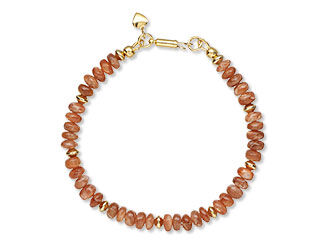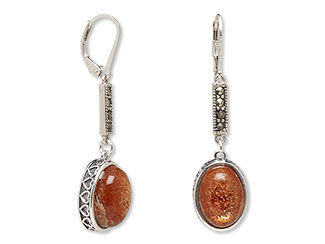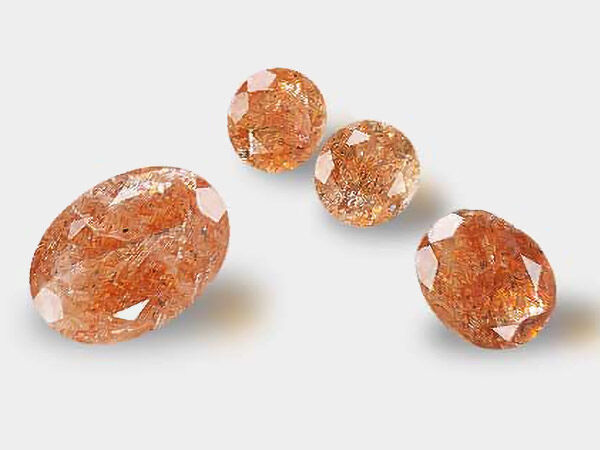Sunstone Meaning and Properties
Sunstone History
Sunstone began as a costly and little-known gemstone until deposits were found in Norway and Siberia. This gemstone has a special history in the United States, where sunstone varieties called "heliolite" have been mined in Oregon. One particular sunstone was found in ancient lava fields of Warner Valley. According to native legend, a great warrior was wounded by an arrow and his blood dripped onto the stones. The spirit of this warrior was carried into the stones and colored them with beautiful tones of red while also imbuing the gems with sacred power.
Explore the enchanting world of sunstone, Oregon’s official gemstone. Uncover the factors behind its sparkling sheen, gain insights into essential care and cleaning practices and embark on a creative adventure to design your own pair of sunstone ear threader earrings. Whether you’re drawn to its radiant appearance or powerful symbolism, learning about sunstone meaning and origins can add depth to your designs.

What are the Metaphysical Properties of Sunstone?
Since "sun" is in this gemstone's name, it's no surprise sunstone is associated with the radiance of the sun and the energy it produces to sustain life. Sunstone is said to be a stone of leadership, encouraging the wearer to be open, benevolent and willing to bestow blessings upon others. Also known as a stone of joy, sunstone properties are believed to inspire good nature and an enjoyment of life. According to metaphysical beliefs, sunstone is highly effective in cleansing auras and chakras. Sunstone is predominantly associated with the Base and Sacral Chakras.
If you’re interested in exploring crystals for emotional and spiritual well-being, the sunstone meaning is often tied to vitality, empowerment and joy—making it a favorite for those seeking balance and light.
What is Sunstone Made From?
Sunstone gems belong to the feldspar group, which encompasses a large variety of gemstone materials—including moonstone and amazonite. The sparkly metallic glitter in this particular feldspar is called aventurescence, caused by flat, reflective inclusions (sometimes called "schiller"). These inclusions can be hematite, copper, or other minerals. Larger inclusions tend to be more glittery, while small inclusions create a red or gold sheen on top of the stone's natural color. Not all sunstones contain aventurescence.
Deposits of sunstone have been found in India, Canada, South Norway, and Russia. Sunstone has also been discovered in the United States, with deposits found in Oregon, where it is the official state gemstone. Most of the sunstone available through Fire Mountain Gems and Beads is from India. These natural variations influence sunstone properties, such as clarity, color saturation and brilliance.
- Mineral Information: Sodium calcium aluminum silicate, Feldspar group
- Chemical Composition: Na(AlSi₃O₈)Ca(Al₂Si₂O₈)
- Color: Orange-red/brown
- Hardness: 6 to 6½ (Mohs)
- Specific Gravity: 2.62 - 2.65
- Refractive Index: 1.532 - 1.542
How Do You Clean Sunstone?
Feldspars, including sunstone, do not react well to harsh cleaners such as bleach and should not be used in ultrasonic or steam cleaners. Exposure to sudden high heat is not recommended. The best method to clean sunstone is to simply use warm, soapy water. Ensure the stone and any jewelry settings are thoroughly dry before storing. Store sunstones away from other harder gemstones that could cause scratching along the surface.
What Chakra is Sunstone?
Chakras are energy centers in the body that correspond to different physical, emotional and spiritual aspects of our being. Sunstone is predominantly associated with the Sacral Chakra, which governs creativity, passion and pleasure. Incorporating sunstone into your chakra practices can help to balance and energize this center.
For those interested in chakra healing, creating or wearing a chakra bracelet featuring sunstone can be a powerful way to harness its energy. These bracelets often combine sunstone with other complementary gemstones to support overall well-being.
For more information on chakras and their corresponding gemstones for making chakra bracelets, refer to our resource: Chakras and Their Gemstones.
Sacral Chakra (Svadhishthana) - Orange
- Location: sacrum (location of the reproductive organs)
- Represents: emotions; openness; relationships; sexuality
- Emotional issues: intimacy; violence; basic emotional needs; pleasure; addiction
- Spiritual issues: enthusiasm; joy
- Physical issues: associated with reproductive system, especially the uterus; urinary tract health
- Gemstones: carnelian, sunstone
Explore these gemstones to create personalized chakra bracelets that resonate with your intentions.
Sunstone FAQ
How does the presence of inclusions or copper platelets affect the appearance of sunstone?
The shimmering effect in sunstone—known as aventurescence—is caused by tiny inclusions of copper or hematite. These platelets reflect light in a glittering display that gives sunstone its signature sparkle.
Where is sunstone found?
Sunstone is found in several locations worldwide, including the United States (especially Oregon), Norway, India, Canada and Tanzania.
Why does sunstone have orange, red or golden hues?
These warm hues are typically due to the presence of copper inclusions. The size, density, and distribution of these inclusions influence the stone’s overall color and shimmer.
Is sunstone a popular gemstone in jewelry designs?
Yes, sunstone’s glowing colors and sparkle make it a favorite for bohemian, nature-inspired and artisan jewelry. It’s especially popular in beadwork, pendants and statement rings.
Is sunstone durable enough for a bracelet that is worn everyday?
With a Mohs hardness of 6 to 6.5, sunstone is moderately durable. It can be used in everyday bracelets, but care should be taken to avoid hard knocks or rough handling.
How can you tell if sunstone is real?
Genuine sunstone has natural inclusions and a subtle glitter that shifts with light. Lab-made imitations may look overly uniform or lack the depth of natural aventurescence.
What other gemstones pair well with sunstone?
Sunstone pairs beautifully with warm-toned gems like citrine, carnelian, garnet, and moonstone. It also complements gold and rose gold metals in jewelry design.
Is sunstone treated to enhance its appearance?
Most sunstone is untreated, though some lower-grade stones may be heated to enhance color. Oregon sunstone is valued for its natural, untreated beauty.
What is the rarest type of sunstone and where can it be found?
The rarest and most valuable type is Oregon sunstone with red, green, or bicolor flashes and strong aventurescence. It is found only in southeastern Oregon and is prized by collectors and designers alike.
Designing with Sunstone
Sunstone, with its rich, earthy red-orange tones, works great in settings of all metal tones. You can't go wrong pairing sunstone with silver, gold, rose gold, copper, or other metals. Pair with moonstone to draw attention to the schiller flash in both of these feldspar minerals. Create a complementary color scheme for high contrast and drama by pairing sunstone with emerald green and lapis lazuli blue. Analogous color schemes call for lemon quartz, citrine, carnelian, ruby reds and a splash of deep purple such as amethyst or tanzanite. The resulting palette is perfect for fall jewelry designs.
A Few Design Inspirations to Get You Started
Follow along with jewelry designer LauraLynn to create a stunning, sunny pair of earrings featuring amethyst and sunstone, Oregon's official state gemstone, and how to design with gorgeous gemstone beads. You won't want to miss this project!

Shop for Sunstone
**Please note that all metaphysical or healing properties listed are collected from various sources. This information is offered as a service and not meant to treat medical conditions. Fire Mountain Gems and Beads® does not guarantee the validity of any of these statements.
How did you like this resource? Your feedback helps us provide resources that matter to you most.
Copyright Permissions
All works of authorship (articles, videos, tutorials and other creative works) are from the Fire Mountain Gems and Beads® Collection, and permission to copy is granted for non-commercial educational purposes only. All other reproduction requires written permission. For more information, please email copyrightpermission@firemtn.com.






